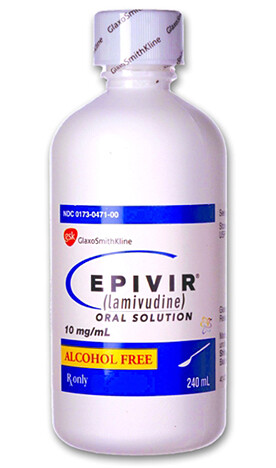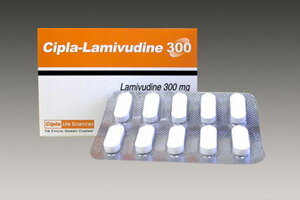Drug Nomenclature: Epivir
International Nonproprietary Names (INNs) in Main Languages
- Synonyms: Lamivudine; 3TC; Epivir-HBV; Zeffix
- INN (English): Lamivudine [rINN]
- INN (Spanish): Lamivudina [rINN]
- INN (French): Lamivudine [rINN]
- INN (Latin): Lamivudinum [rINN]
- INN (Russian): Ламивудин [rINN]
Chemical Information
- Chemical Name: (2R,cis)-4-amino-1-(2-hydroxymethyl-1,3-oxathiolan-5-yl)-(1H)-pyrimidin-2-one
- Molecular Formula: C8H11N3O3S
- CAS Number: 134678-17-4
Classification Codes
- ATC Code: J05AF05
- Read Code: y00zj
Lamivudine is a nucleoside reverse transcriptase inhibitor, which inhibits replication of HIV and hepatitis B virus (HBV). HIV infection: Epivir is used in combination with other antiretroviral agents for the treatment of HIV infection. Chronic hepatitis B: Epivir-HBV is used in the treatment of chronic hepatitis B associated with evidence of hepatitis B viral replication and active liver inflammation.

Lamivudine, the (-)-enantiomer of 2′,3′-dideoxy-3′-thia-cytidine, is a nucleoside analog that inhibits HIV reverse transcriptase and HBV DNA polymerase. It inhibits HBV replication in vitro by 50% at concentrations of 4 to 7 ng / mL with negligible cellular cytotoxicity. Cellular enzymes convert lamivudine to the triphosphate, which competitively inhibits HBV DNA polymerase and causes chain termination. The intracellular t1/2of the triphosphate averages 17 to 19 hours in HBV-infected cells, so infrequent dosing is possible.
Lamivudine triphosphate is a potent inhibitor of the DNA polymerase; reverse transcriptase of HBV, and oral lamivudine is active in animal models of hepadnavirus infection. Lamivudine shows enhanced antiviral activity in combination with adefovir or penciclovir against hepadnaviruses. Point mutation in the YMDD motif of HBV DNA polymerase results in a 40 to 104 times reduction in in vitro susceptibility. Lamivudine resistance confers cross-resistance to related agents such as emtricitabine and clevudine and is often associated with an additional non-YMDD mutation that confers cross-resistance to famciclovir. Lamivudine-resistant HBV retains susceptibility to adefovir and partially to entecavir. Viruses bearing YMDD mutations are less replication competent in vitro than wild-type HBV. However, lamivudine resistance is associated with elevated HBV DNA levels, decreased likelihood of HbeAg loss or sero-conversion hepatitis exacerbations, and progressive flbrosis and graft loss in transplant recipients.
Following oral administration, lamivudine is absorbed rapidly with a bioavailability of about 80% in adults. Peak plasma levels average approximately 1000 ng / mL after 100-mg doses.
Lamivudine is distributed widely in a volume comparable with total-body water. The plasma tmof elimination averages about 9 hours, and approximately 70% of the dose is excreted unchanged in the urine. About 1% is metabolized to an inactive trans-sulfoxide metabolite. In HBV-infected children, doses of 3 mg / kg per day provide plasma exposure and trough plasma levels comparable with those in adults receiving 100 mg daily. Dose reductions are indicated for moderate renal insufficiency (creatinine clearance <50 ml / min). Trimethoprim decreases the renal clearance of lamivudine.
At the doses used for chronic HBV infection, lamivudine generally has been well tolerated. Aminotransferase increases after therapy occur more often in lamivudine recipients, and flares in posttreatment aminotransferase elevations (>500 IU / mL) occur in about 15% of patients after cessation.
Lamivudine is approved for the treatment of chronic HBV hepatitis in adults and children. In adults, doses of 100 mg / day for 1 year cause suppression of HBV DNA levels, normalization of aminotransferase levels in 41% or more of patients, and reductions in hepatic inflammation in over 50% of patients. Seroconversion with antibody to HbeAg occurs in fewer than 20% of recipients at 1 year. In children aged 2 to 17 years, lamivudine (3 mg / kg per day to a maximum of 100mg for 1 year) is associated with normalization of aminotransferase levels in about one-half and seroconversion to anti-Hbe in about one-fifth of cases. In those without emergence of resistant variants, prolonged therapy is associated with sustained suppression of HBV DNA, continued histological improvement, and an increased proportion of patients experiencing a virological response (loss of HbeAg and undetectable HBV DNA). Prolonged therapy is associated with an approximate halving of the risk of clinical progression and development of hepatocellular carcinoma in those with advanced fibrosis or cirrhosis. However, the frequency of lamivudine-resistant variants increases progressively with continued drug administration, and frequencies of 38%, 53%, and 67% have been found after 2, 3, and 4 years of treatment, respectively. The risk of resistance development is higher after transplantation and in HIV / HBV-coinfected patients.

Combined use of IFN or pegIFN alfa-2a with lamivudine has not improved responses in HBeAg-positive patients consistently. The addition of lamivudine to pegINF alfa-2a for 1 year of therapy does not improve post-treatment response rates in HBeAg-negative patients. In HIV and HBV coinfections, higher lamivudine doses are associated with antiviral effects and, uncommonly, anti-HBe seroconversion. Administration of lamivudine before and after liver transplantation may suppress recurrent HBV infection.












